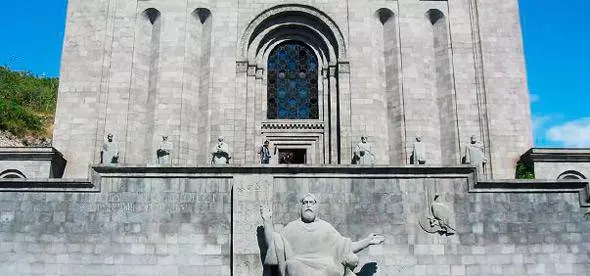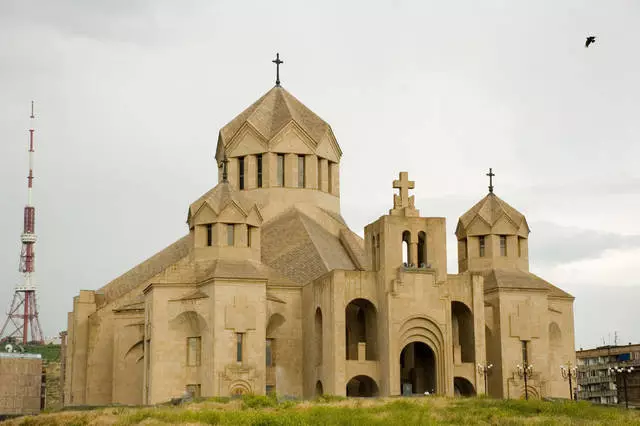The capital of Armenia has many landmarks, if you meet with whom you can learn about the history of the formation of the state and its outstanding personalities.
In this article we will talk only about some of the notable places of Yerevan. So, let's begin.
Storage of ancient manuscripts Matenadaran
In the ancient and the "Matenaadaran" means "book storage". This is the largest in the world (!) Storage of old manuscripts. It is located on the avenue of Mesrop Mastots. Mesrop Mashotots created the Armenian alphabet and was the founder of writing.
This storage was created in 1959 - as a research institute of ancient manuscripts. For centuries, during which military actions were going and destruction took place, the manuscripts were collected and burned in the monastery of Echmiadzin. In the 1920s they were nationalized. To this day, texts have been preserved, dated by the period of the beginning of Armenian writing, as well as other documents - Greek, Arab, Syrian, Russian ... Armenians are proud of this ancient collection, Mathenadaram is a huge value for researchers who study philosophy, history and science of these countries. Visitors to storage facilities that know the felt in applied arts can also admire the samples of ancient tissues, examples of skin stamping and artistic forging for metal, antique technologies used in typography.

The structure of the manuscript repository was erected in the traditional Armenian architectural style of the twelfth-thirteenth century. Near Matrenadaran is a monument to the founder of Armenian writing and other outstanding historical individuals.
Museum Tamanyan
It takes a small room in the structure located on the Republic Square (Government House, 3rd Corps). Many locals consider Alexander Oganesovich Tamanyan not only by the architect and town planner, but also the father of the capital. The fruits of his work live to this day, the entire central part of the city is a visual testimony of his work. When new quarters are design, it is always repelled from the master plan developed by A.Tamanyan.
Having visited this museum, you will learn about the life of this outstanding architect, familiarize yourself with his family photos and originals of the projects that he created in different periods of his life, including the project of the Erivuni reconstruction project.
Erebuni Fortress
Officially considered the oldest part of the city. From here, from this fortress, in 782nd BC and the Erybuni began to build. But at the beginning of the last century, the location of the fortress was not known. In the middle of the twentieth century, archaeological works were performed here - then the ruins of the ancient fortress and the remnants of many buildings were discovered. They were restored, and now tourists go here. Nearby is the Museum of Erebuni.

Museum of Erebuni
Located under the hill Arin-Berd, where the fortress is located, having the same name. Opened the museum in 1968, this event was timed to the 2750th anniversary of the city. Here you can see the ancient artifacts found in the archaeological excavations of the fortress - items from bronze, archaeons, decorations, dishes, as well as elements of mosaic and frescoes, which spare time.
Blue Mosque
Blue Mosque Yerevan is a cathedral mosque. Her in 1766 heal the Persian Khan of the Erivan Khanate. At the beginning of the last century, the mosque had four minarets, but at Soviet power three of them were destroyed. Thanks to the economic assistance provided by Iran, the mosque was restored in nineties, and today it is one of the cultural centers of the local Iranian community.
Cathedral of St. Gregory Enlightener
This cathedral is one of the largest in the Caucasus. The beginning of work on its construction dates back to 1997th year. The temple was consecrated in 2001. It stores relics that are related to Gregory to the Enlightener. The construction of the temple complex was conducted for money that the famous Armenian surnames donated.

The style of this building is the same as inherent in traditional Armenian architectural solutions, but there are also differences - other local churches are not so large, bright and spacious as this.
North Avenue
The North Avenue is a modern pedestrian street starting from ul. Abovyana is near the Republic Square. The Northern Avenue, in general, is the opposite of the quarter of Cond: there are a lot of cafes, shops with prices above average, and behind them - new highlights. The quarter is not for the poor, so the apartments here are standing in other capitals of the world. During the evening walk, it can be found that there are few here in homes and light, so the highlights at dusk with their dark silhouettes resemble the mountains. Local residents can find out that the owners of these apartments are the rich Armenians who live abroad, and they remember their homeland only for the time of vacation or urgent cases returning them to Yerevan.
Museum of Sergei Parajanova
This museum is located in the Dzoragyu - Ethnographic Quarter of Kentron, the administrative district of the city. Here you can get acquainted with the biography and contribution to art, which is the merit of Sergey Parajanov. The artist, director, this creative person created a new language of art, uniting the elements of sculpture, painting and cinema. In the historical homeland, he never had a chance, but all his works Sergei Paradzhanov bequeathed to her.
Monument to David Sasunsky
David Sasunin always personified the symbol of freedom and independence of Armenians, their readiness to protect their land from enemies. The location of the monument is the station square. On the basalt pedestal there is a rider figure on horseback, and near the granite base - a bowl that symbolizes the patience of the Armenian people.
Opera and Ballet Theatre
Located in the central part of the city. The building project belongs to the architect Alexander Tamanyan, the style of the construction is Soviet neoclassicism, but the decoration, carving and decor reflect folk motives. The peculiarity of this institution of culture is in its unusual device: one half of the building is philharmonic, and the other is the Opera and Ballet Theater.
In the square, located close to the theater, there are cafes and a small artificial reservoir - "Swan Lake", where in winter it is equipped with a rink. In the summer, youth resting here in the evenings.
